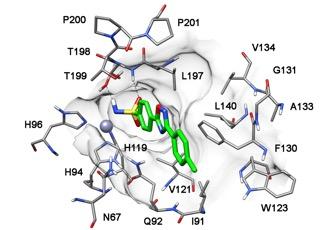Chemists have created compounds that can treat glaucoma

Docking one of the hit compound into human Carbonic Anhydrase II isoform Credit: Anton Shetnev
The study is focused on benzenesulfonamide derivatives containing a 1,2,4-oxadiazole moiety. “It was the first time that these compounds were considered as potential inhibitors of human carbonic anhydrase. Managing the enzyme's activity in ciliary processes using this compoundswe can normalize the intraocular pressure,” says Anton Shetnev, one of the authors of the paper from RUDN University.
Carbonic anhydrases comprise a family of widespread enzymes that facilitate CO2-bicarbonate interconversion in all tissues of human body. Their function is to catalyze the reversible hydration of carbon dioxide, which produces bicarbonate anion and a proton.
This simple biochemical reaction is central to regulating pH in the intra- and extracellular space in various tissues and organs. It should be noted that carbonic anhydrase in performed by 15 isoforms (isoenzymes) localized in various tissues and slightly differing in the active site architecture. Sulfonamide-based inhibitors bind to the prosthetic zinc-ion in the catalytic cavity, thussuppressing activity of the enzyme which can be described as a “key-lock” interaction.
Most of known carbonic anhydrase inhibitors can be compared to a master key which relatively roughly opens any lock-enzyme (all isoforms)of the corresponding family. Since the affinity is non-selective (that is, there is no key thread exactly entering the grooves), such an agent might cause plenty of undesired effects. When developing a drug candidate, either potency of selectivity of the inhibitor are crucial.
The latter could be achieved by designing sulfonamide-incorporating small-molecules bearing appropriate molecular periphery.Our study shows that by attaching substituted oxadiazole ring to the benzenesulfonamide fragment substantional improvement in potency and selectivity of the inhibition can be achieved, thus suggesting this scaffold to be promising for the development of new antiglaucoma drugs.
“We are now to continue improving the selectivity of our inhibitors on the next stages of our work: we need to conduct research aimed at further modification of the compounds in order tomaximize affinity only to the target isoforms, regulating intraocular pressure, which is a great challenge” Anton Shetnev concludes.
###
The research was carried out jointly with Saint Petersburg State University, Yaroslavl State Pedagogical University named after K.D. Ushinsky and Italian colleagues from University of Florence and University of Piza.
Media Contact
All latest news from the category: Life Sciences and Chemistry
Articles and reports from the Life Sciences and chemistry area deal with applied and basic research into modern biology, chemistry and human medicine.
Valuable information can be found on a range of life sciences fields including bacteriology, biochemistry, bionics, bioinformatics, biophysics, biotechnology, genetics, geobotany, human biology, marine biology, microbiology, molecular biology, cellular biology, zoology, bioinorganic chemistry, microchemistry and environmental chemistry.
Newest articles

Bringing bio-inspired robots to life
Nebraska researcher Eric Markvicka gets NSF CAREER Award to pursue manufacture of novel materials for soft robotics and stretchable electronics. Engineers are increasingly eager to develop robots that mimic the…

Bella moths use poison to attract mates
Scientists are closer to finding out how. Pyrrolizidine alkaloids are as bitter and toxic as they are hard to pronounce. They’re produced by several different types of plants and are…

AI tool creates ‘synthetic’ images of cells
…for enhanced microscopy analysis. Observing individual cells through microscopes can reveal a range of important cell biological phenomena that frequently play a role in human diseases, but the process of…





















